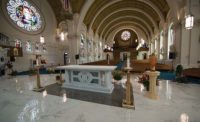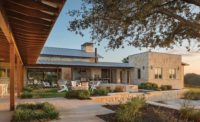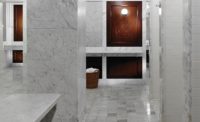Built in 1986, the Segerstrom Center for the Arts is a cultural landmark in Costa Mesa, CA, which through the years has undergone expansion projects to further develop it as a premier performance venue. Most recently, a stunning fountain constructed of black basalt from China was designed to create a focal attraction at the main entrance to the Renee and Henry Segerstrom Concert Hall.
“The design criteria was to provide a dramatic visual emphasis for the arrival, enhancing the experience with spirited water expressions that were iconic and in harmony with the buildings dramatic arch and the ‘Fire Bird’ sculpture by Richard Lippold,” explained Tom Yankelitis, principal and vice president of Fluidity Design Consultants Inc. in Los Angeles, CA, who designed the fountain. “The form of the waterjet arrangement drew inspiration from Alexander Calder’s ‘Flamingo’ sculpture at Federal Plaza in Chicago. Custom one-of-a-kind waterjets were developed to work at a scale necessary to fill the space above the reflection pool.
“The design intent from the outset was to have a reflective infinity edge base pool,” Yankelitis went on to say. “Black or dark hues provide the best reflectivity. We selected a number of black and dark-hued stones and narrowed the field based on uniformity, speed of delivery and cost. The basalt was our favored choice for its uniformity, and luckily it was within budget and its lead-time fit the construction schedule.”
FINDING THE APPROPRIATE STONE
When navigating the stone selection process, there was some criteria that needed to be considered when determining what stone would be most appropriate for the project. “Water features are harsh environments; stone typically must resist chemicals and the friction of water,” explained Yankelitis. “We look for dense stone types like granite, quartzite, basalt and some slates, while trying to avoid marble, limestone and sandstone. For this project, we worked closely with the architect, client, general contractor and specialty fountain contractor due to the short project timeline.”
The stone was supplied by NuWa Stone of Santa Ana, CA, and distributed through Stone Source’s Los Angeles location. Gracie Morris, president/CEO of NuWa Stone, worked closely with representatives at Stone Source, as well as others involved with the project, to ensure the success of the fountain.
“I provided different types of samples to Stone Source to help the designers and architects figure out what they needed,” she said. “They initially picked something that wasn’t suitable to be submerged under water. I helped them figure out what was aesthetically appealing and cost effective. Once the stone was selected, I worked with the engineering company, Pacific Aquascape International, who was instrumental to the stone installation.”
According to Morris, the fountain is about 60 feet long in diameter. “Each piece was cut at a radius – even the vertical pieces — and varying thicknesses because of what needed to go under the stone, like the piping,” she explained, adding there was a total of 933 custom-cut stone pieces. “We had to focus on how each piece fit together perfectly. The team here had no capacity to fabricate these pieces in such a short amount of time because they were so large and thick, at different heights, lengths and shapes. It was a very complicated job.”
Yankelitis explained that he and his team from Fluidity Design Consultants Inc. reviewed the stone shop drawings and photos of the stone layout from the fabricator prior to shipping. We conducted several site visits while the stone was being installed. We looked for levelness, consistent joint spacing and any damaged pieces.
“The levelness of the stone weir and its alignment with the curved vertical cladding was the most challenging part of the stonework due to the tight construction tolerance,” Yankelitis went on to say. “The water flow over the weir and on the cladding would easily be disturbed if those pieces were slightly out of level
or alignment.”
A COMPLEX INSTALLATION
Adrian Garcia of Pacific Aquascape International in Fountain Valley, CA, also spoke of the fountain’s complexity due to the unevenness. “If you look at a bird’s eye view [of the fountain], the pattern of the stone does not include symmetrical pieces,” he said. “The existing roundabout slope of the street was an important factor for the stone installation. All of the vertical face pieces were cut to different heights. There was a difference of 12 inches from one side to another.”
Garcia explained that the team at Pacific Aquascape International worked hand-in-hand with Yankelitis, the architect and the contractor to do the small details. “We helped bring it together.
“We have been in business 30 to 40 years,” Garcia went on to say. “We construct manmade lakes, fountains, splash pads – any feature with water and water patterns we can do. The most challenging aspect of the project was determining the exact dimensions of all of the stone pieces. The calculations for the vertical face pieces was challenging because the slope of the street had to be taken into account. We ordered nine different stone heights to make sure they all look symmetrical on the vertical face. We couldn’t just order them all at 3 feet tall because in some cases we only needed to have them be 18 inches. There were a few days of coordinating and layout to make sure everyone was on the same page as to where each distinct stone piece needed to go.”
Garcia also collaborated closely with Morris. “We spent about two months going back and forth with the calculations,” said Garcia. “Before the stone was ordered and finalized there were numerous revisions of shop drawings. We created true size templates that had the correct radii and dimensions. The installation was simplified for the field crew to put together due to the long hours spent in the office. Once the pieces arrived on site, the installer did not encounter any major problems. Another unique aspect contributing to the stone was the fact the architect and owner wanted a layout that looked like a dart board. It was very intricate. Gracie and her team were amazing on this project.”
Further contributing to the high-pressure of the job was the hard deadline of October 28, 2017 that needed to be met. “It was stressful getting the material here on time for the Grand Opening,” explained Morris. “They came to me in July and had already sent out an announcement about a Grand Opening for October. It was a super tight time frame. There were issues with U.S. Department of Agriculture (USDA) randomly holding containers, which caused delays.”
Garcia explained that the last shipment of stone arrived during the second week of October. “Once it arrived on site, Gracie and myself were out there. I was out there the last three weeks until it was completed. We met and reviewed pieces – making sure it was all good. I made sure we conveyed the layout to the guys. Each piece was very unique. There were some pieces that were the same size, but if you didn’t understand the layout, you wouldn’t understand where they would go. About a third of the pieces are removable. It changes the thickness of the pieces. We had to pull string lines to make sure the dimensions were correct. It was a big puzzle.”
In the end, the result of the hard work paid off and the deadline was met. “We’ve heard nothing but great reviews from the client and public,” said Yankelitis. “We are very pleased with the success of the design and quality of the stonework.”
Morris shared the fountain designer’s sentiments. “It’s located in such a prestige area,” she said. “My kids and I love to go see the theater and orchestra performances. To see kids and families around the fountain is so rewarding. On the wholesale side, I don’t usually get to see where the stone goes. This is local for me. It’s five minutes from my office so I get to enjoy it with my family and friends. It is so nice.”
|
Segerstrom Center for the Arts Fountain Costa Mesa, CAFountain Designer: Fluidity Design Consultants, Los Angeles, CA Fountain Engineer: Pacific Aquascape International, Fountain Valley, CA Stone Importer: NuWa Stone, Costa Mesa, CA Stone Distributor: Stone Source, Los Angeles, CA |









